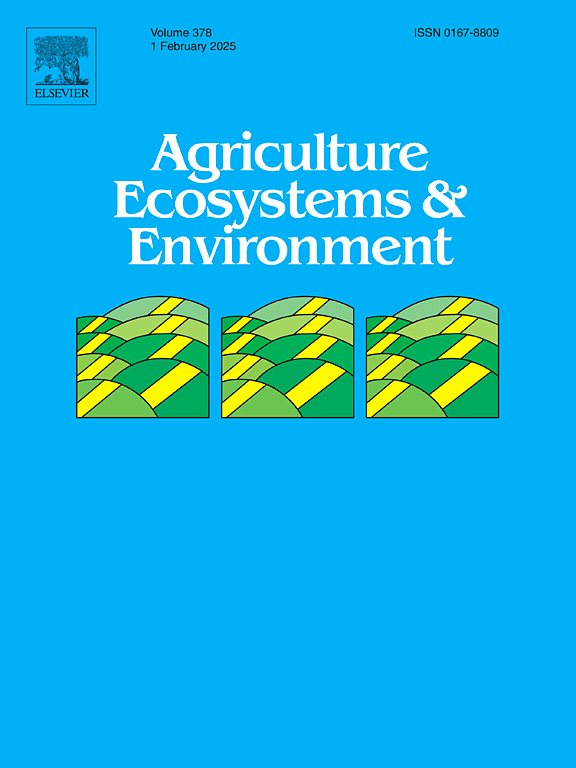经过30年的农业河岸系统修复,细菌群落结构和恢复力部分恢复
IF 6.4
1区 农林科学
Q1 AGRICULTURE, MULTIDISCIPLINARY
引用次数: 0
摘要
土壤微生物群在维持土壤生态系统功能方面发挥着重要作用,可以作为退化土地恢复过程中生态系统恢复的指标。本研究比较了扰动梯度下土壤微生物群落结构和潜在活性细菌群落共现模式:扰动农田(AGR)、先前扰动恢复农林业(RHF)和未扰动天然林(UNF)。我们使用qPCR对DNA和cDNA进行定量,并对潜在的活性细菌群落进行高通量扩增子测序。细菌转录物丰度在UNF中显著高于AGR,潜在活性细菌群落的组成沿干扰梯度变化显著。土壤温度、硝酸盐、pH、碳氮比和总碳是导致细菌群落组成差异的关键土壤性质。在干扰梯度上,Burkholderiales、haaliangium和Pseudomonas等关键分类群的丰度存在差异。网络鲁棒性用于评估网络弹性,在UNF中最高,在AGR中最低,而RHF为中等,表明RHF在干扰后部分恢复。森林土壤轮毂以放线菌门的少营养菌为主,以假单胞菌门的轮毂为主。UNF是唯一具有像TRA3-20这样的营养丰富的中心类群的站点,反映了在营养丰富和较少干扰的条件下功能多样化的网络组合。这些发现表明,经过30年的恢复,RHF在微生物丰度、组成和土壤特征方面与UNF相似,表明该地点的生态系统功能有所恢复。本文章由计算机程序翻译,如有差异,请以英文原文为准。
Bacterial community structure and resilience are partially restored after 30 years of rehabilitation of an agricultural riparian system
Soil microbiomes play critical roles in maintaining soil ecosystem functions, and therefore, they can be indicators of ecosystem recovery during the rehabilitation of degraded land. This study compared microbial community structure and co-occurrence patterns of potentially active bacterial communities in soils from a disturbance gradient: disturbed agricultural land (AGR), previously disturbed rehabilitated agroforest (RHF), and undisturbed natural forest (UNF). We quantified DNA and cDNA using qPCR and performed high-throughput amplicon sequencing to target potentially active bacterial communities. Bacterial transcript abundance was significantly higher in UNF compared to AGR, and the composition of potentially active bacterial communities varied significantly along the disturbance gradient. Soil temperature, nitrate, pH, carbon-to-nitrogen ratio, and total carbon were key soil properties driving differences in bacterial community composition. Key taxa such as Burkholderiales, Haliangium, and Pseudomonas, were differentially abundant along the disturbance gradient. Network robustness was used to evaluate network resilience and was highest in UNF, lowest in AGR, and RHF was intermediate, suggesting partial recovery of RHF following disturbance. Hub taxa from AGR were oligotrophs mainly from the phylum Actinomyceota, while forest soils hubs were from the phylum Pseudomonodata. UNF was the only site to have copiotrophic hub taxa such as TRA3–20, reflecting a functionally diverse network assembly in the nutrient-rich and less disturbed conditions. These findings show that after 30 years of rehabilitation the RHF has a similarity to UNF in terms of microbial abundance, composition, and soil characteristics, suggesting a recovery in ecosystem functionality at the site.
求助全文
通过发布文献求助,成功后即可免费获取论文全文。
去求助
来源期刊

Agriculture, Ecosystems & Environment
环境科学-环境科学
CiteScore
11.70
自引率
9.10%
发文量
392
审稿时长
26 days
期刊介绍:
Agriculture, Ecosystems and Environment publishes scientific articles dealing with the interface between agroecosystems and the natural environment, specifically how agriculture influences the environment and how changes in that environment impact agroecosystems. Preference is given to papers from experimental and observational research at the field, system or landscape level, from studies that enhance our understanding of processes using data-based biophysical modelling, and papers that bridge scientific disciplines and integrate knowledge. All papers should be placed in an international or wide comparative context.
 求助内容:
求助内容: 应助结果提醒方式:
应助结果提醒方式:


